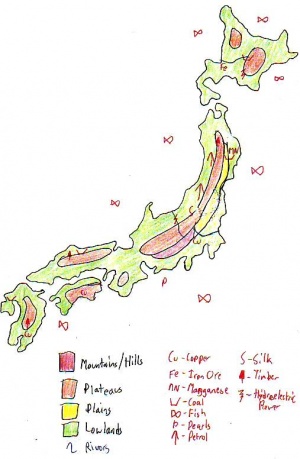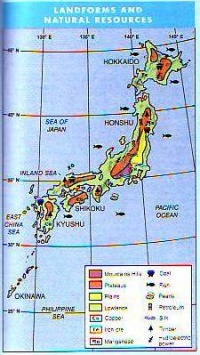Difference between revisions of "World Cultures Portfolio/Japan"
From ThePlaz.com
(add red book) |
(do a lot of the 1st draft (1hr)) |
||
| Line 8: | Line 8: | ||
[[Image:Japan Natural Resources Map.JPG|thumb|300px|Japan Natural Resources Map]] | [[Image:Japan Natural Resources Map.JPG|thumb|300px|Japan Natural Resources Map]] | ||
[[Image:Japan Natural Resources Textbook.JPG|thumb|200px|Textbook Japanese Landforms Map]] | [[Image:Japan Natural Resources Textbook.JPG|thumb|200px|Textbook Japanese Landforms Map]] | ||
| + | |||
| + | Japan, an nation unlike any other. Fiercely independent and self-sufficient for centuries, it has now arisen into one of the most powerful industrial nations on earth. Japan has managed to get around it's small size due to the fierce loyalty and trustworthiness of the Japanese people. For centuries, Japan's lack of resources did not hurt it. It had what it needed. But as the age of industrialization came, Japan knew it needed more. It want to war to try and steal natural resources from others. Today, the old boundaries came back. But Japan has realized how to industrialize its self without the need for many resources. | ||
| + | |||
| + | Japan's real birth occurred from the volcanoes which make up the Pacific rim of fire. This has many implications for the Japanese. Unlike normal earth, volcanic rock doesn't hold many resources. All of the plants and animals needed to have come from the mainland. In addition, the fault lines mean a large possibility for earthquakes and volcanoes. More then thirty active volcanoes make up Japan, and as many as 1,500 tremors happen each year (Blue 390). These can have devastating damage on the buildings of the Japanese. They have dedicated entire research institutes to researching earthquakes and earthquake proof buildings. | ||
| + | |||
| + | Japan, like Korea, has many mountains. More than four/fifths of Japan has little population living in it due to the mountains (Blue 390). This means that almost of the 125 million people live in the small coastal plains (Blue 390). As a comparison, Japan has the seventh largest population squeezed in to a nation a bit larger then Great Britain, and that's before you account for all of the mountains. | ||
| + | |||
| + | Japan has managed, somewhat, do deal with its small space. Many Americans think of the capsule hotels when they think of this problem. The hotels "room" only consist of a bed, like a bunk bed, but with the smaller end facing the room. The door can be closed for privacy and peace. However, most tourists sleep there only one night for the novelty. However, the Japanese also use technology to solve their problems, such as a robotic parking garage. You drive your car onto a platform, get out, pay, and then the platform moves into a slot for storage. | ||
| + | |||
| + | The map indicates that all but the smallest island in Japan has coal. As industrialization started, one needed coal as the primary fuel source in factories. Today oil has taken coal's place. The Honshu island has many trees which one can harvest for lumber. Paper and furniture then gets produced from wood. Also on the islands of Honshu and Hokkaido fast flowing streams have the potential for hydroelectric power plants. Hydroelectric power will not run out and does not directly pollute the environment. | ||
| + | |||
| + | imports+exports | ||
| + | fishing | ||
==Sources== | ==Sources== | ||
| + | 1/20 | ||
| + | *cia world factbook | ||
| + | *blue book | ||
*<u>Global Insights: People and Cultures</u>. Glencoe/McGraw-Hill, 1993. | *<u>Global Insights: People and Cultures</u>. Glencoe/McGraw-Hill, 1993. | ||
Revision as of 21:14, 20 January 2007
World Cultures Japan Report about Natural Resources
Intro/Basics - Africa - Middle East - South Asia - China - Japan - Korea - Latin America
Africa: HDI Graph Reflections - Decolonization Report
Middle East: Population Density Report - Essay: A Peaceful Vacation
South Asia: Rainfall Report - South Asia Comparisons Graph - Postcards
China: Sphere of Influences Report - Mao Button Journal
Japan: Natural Resources Report - Japanese Violence Journal
Korea: Physical Map Report
Latin America: Landforms Report
Worldwide: T-Shirt Trade Report
Japan, an nation unlike any other. Fiercely independent and self-sufficient for centuries, it has now arisen into one of the most powerful industrial nations on earth. Japan has managed to get around it's small size due to the fierce loyalty and trustworthiness of the Japanese people. For centuries, Japan's lack of resources did not hurt it. It had what it needed. But as the age of industrialization came, Japan knew it needed more. It want to war to try and steal natural resources from others. Today, the old boundaries came back. But Japan has realized how to industrialize its self without the need for many resources.
Japan's real birth occurred from the volcanoes which make up the Pacific rim of fire. This has many implications for the Japanese. Unlike normal earth, volcanic rock doesn't hold many resources. All of the plants and animals needed to have come from the mainland. In addition, the fault lines mean a large possibility for earthquakes and volcanoes. More then thirty active volcanoes make up Japan, and as many as 1,500 tremors happen each year (Blue 390). These can have devastating damage on the buildings of the Japanese. They have dedicated entire research institutes to researching earthquakes and earthquake proof buildings.
Japan, like Korea, has many mountains. More than four/fifths of Japan has little population living in it due to the mountains (Blue 390). This means that almost of the 125 million people live in the small coastal plains (Blue 390). As a comparison, Japan has the seventh largest population squeezed in to a nation a bit larger then Great Britain, and that's before you account for all of the mountains.
Japan has managed, somewhat, do deal with its small space. Many Americans think of the capsule hotels when they think of this problem. The hotels "room" only consist of a bed, like a bunk bed, but with the smaller end facing the room. The door can be closed for privacy and peace. However, most tourists sleep there only one night for the novelty. However, the Japanese also use technology to solve their problems, such as a robotic parking garage. You drive your car onto a platform, get out, pay, and then the platform moves into a slot for storage.
The map indicates that all but the smallest island in Japan has coal. As industrialization started, one needed coal as the primary fuel source in factories. Today oil has taken coal's place. The Honshu island has many trees which one can harvest for lumber. Paper and furniture then gets produced from wood. Also on the islands of Honshu and Hokkaido fast flowing streams have the potential for hydroelectric power plants. Hydroelectric power will not run out and does not directly pollute the environment.
imports+exports fishing
Sources
1/20
- cia world factbook
- blue book
- Global Insights: People and Cultures. Glencoe/McGraw-Hill, 1993.




